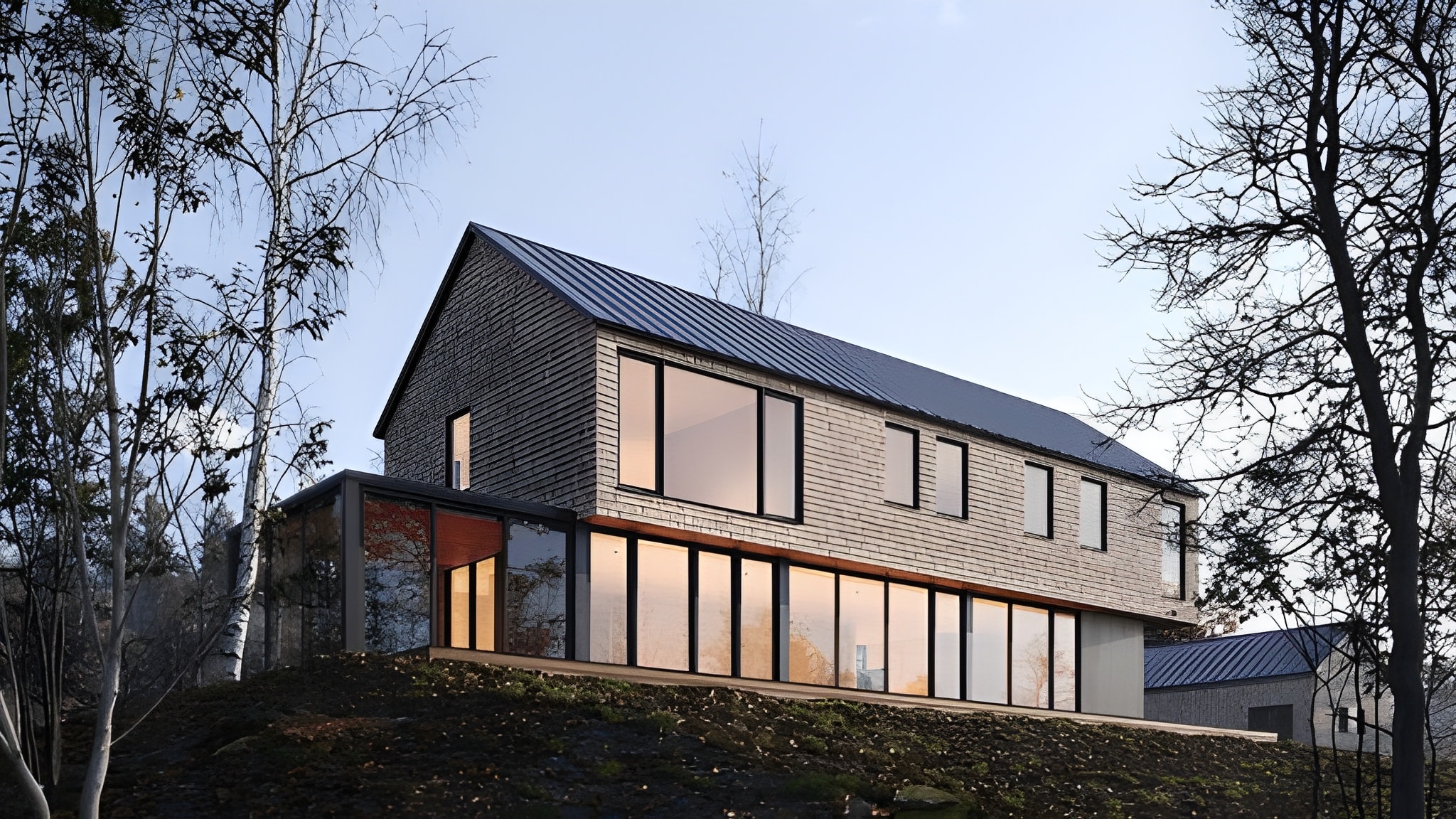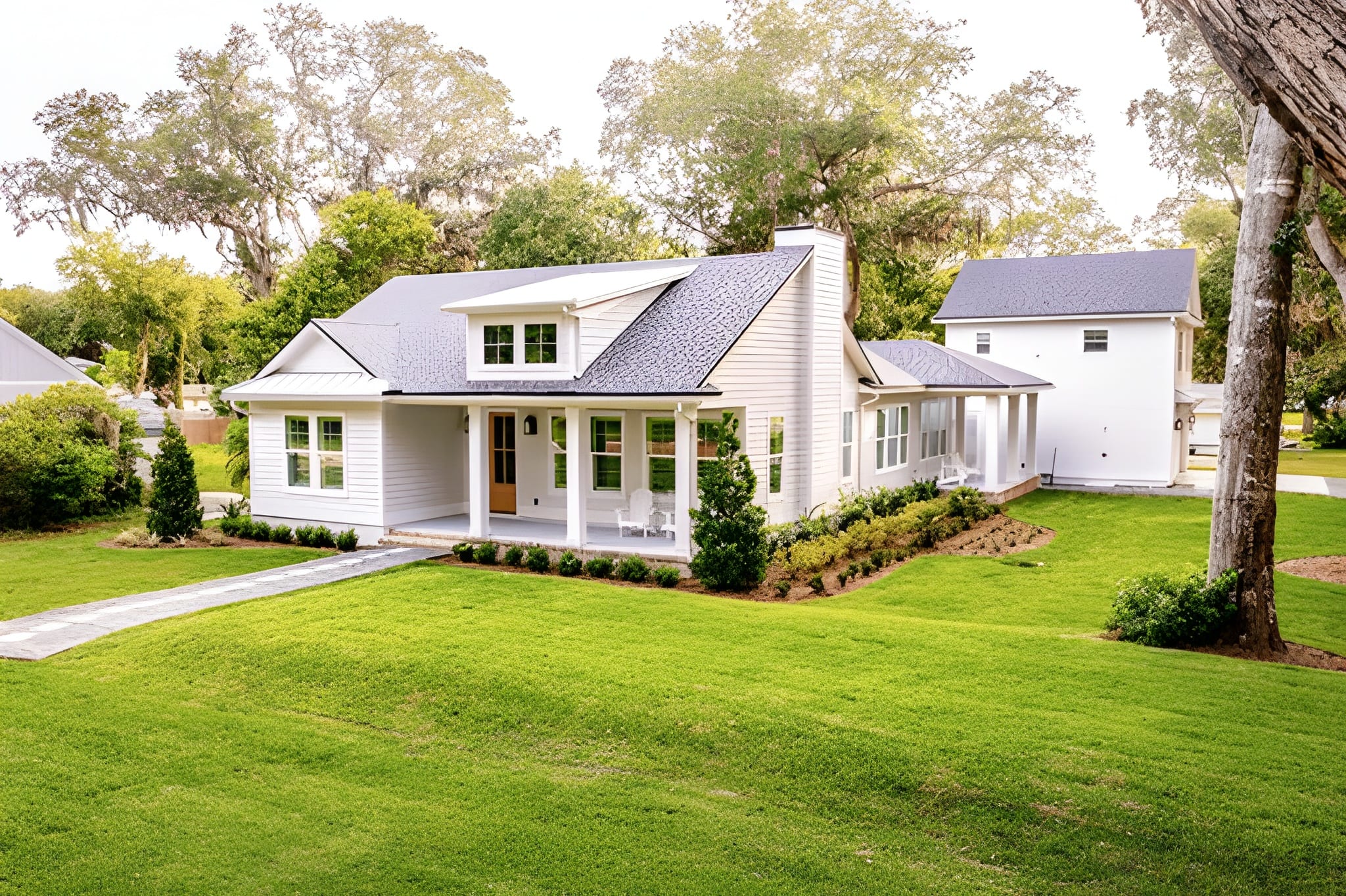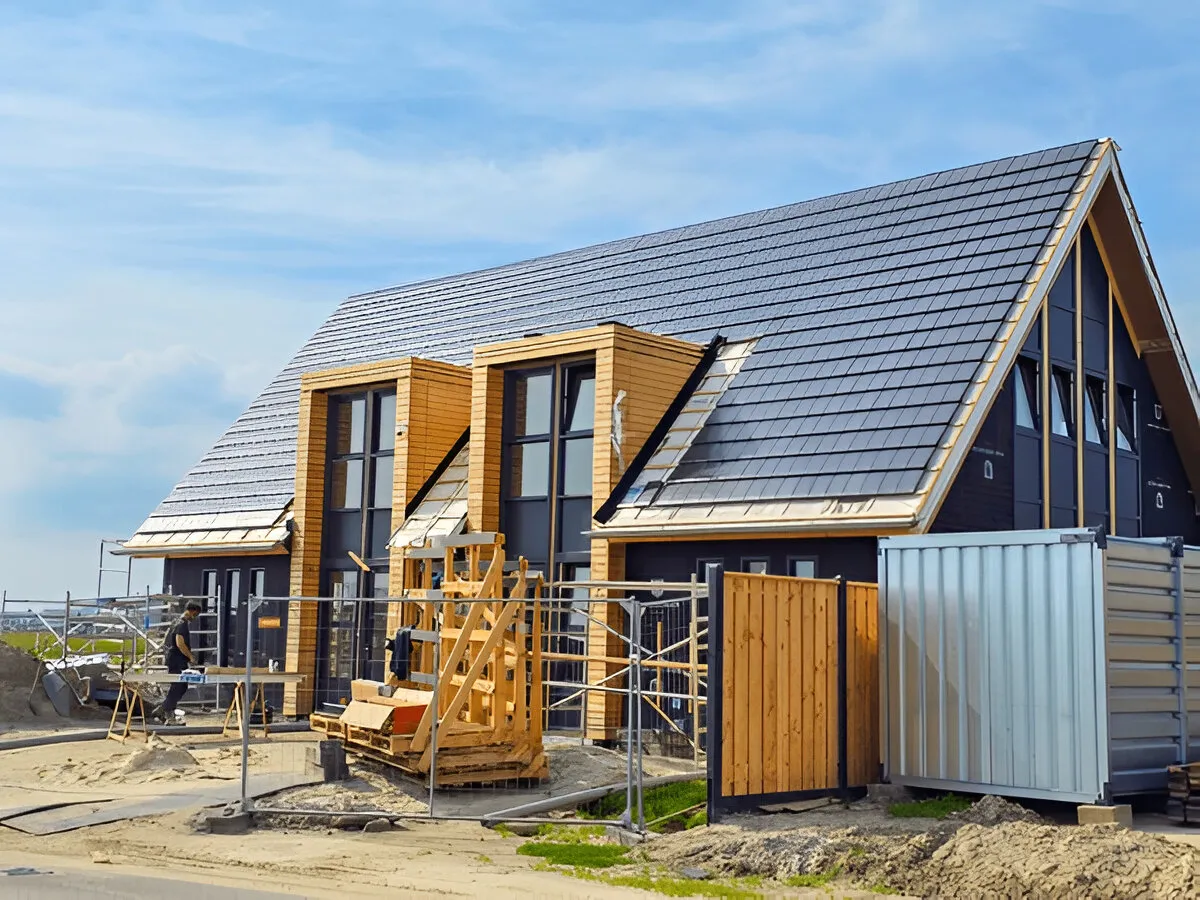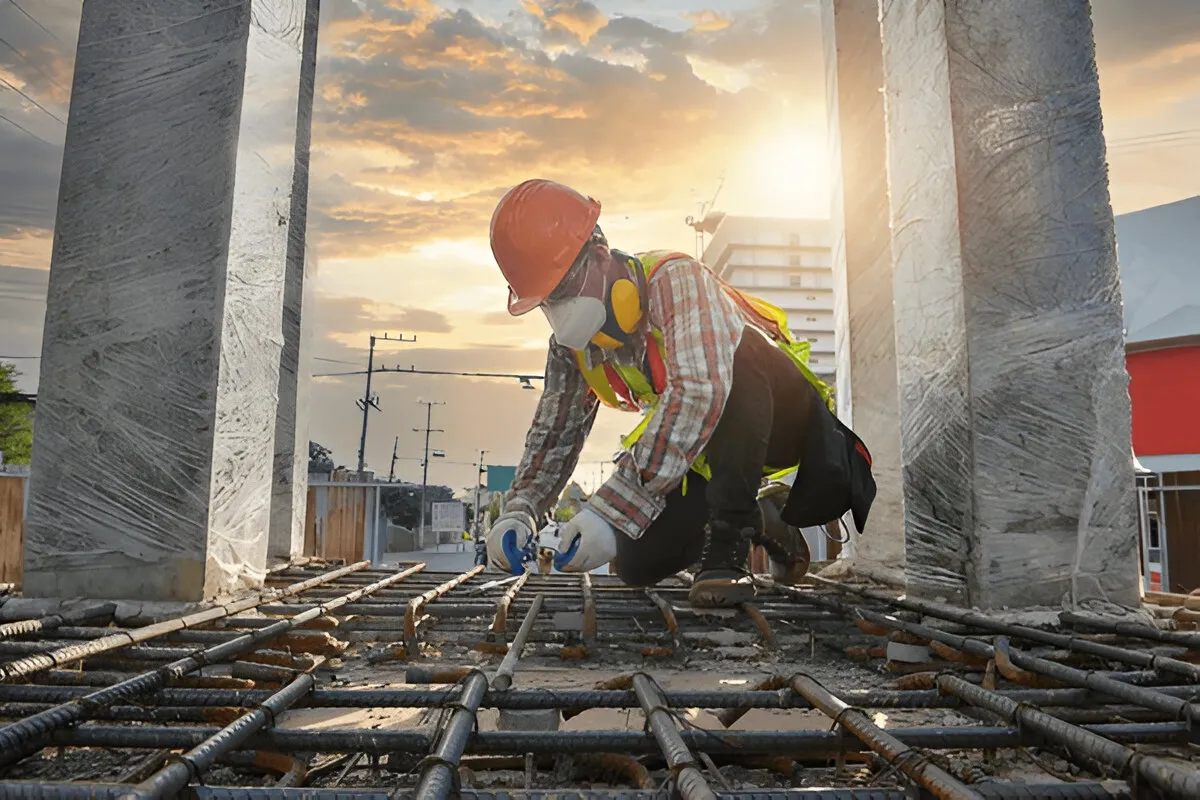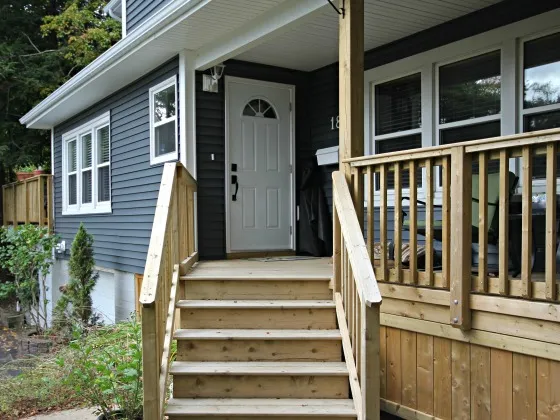Whether you’re planning a full kitchen remodel or just a few upgrades, picking a countertop can be tricky. Aside from settling on the look, there are plenty more pros and cons to consider. A few quick tips:
- You should expect to budget about 10 to 15 percent of your kitchen remodeling budget on countertops and installation.
- Colours and trends come and go – if you have resale value in mind, it’s safest to keep things neutral.
- Consider include a section of wood for chopping or marble for rolling dough.
- A different color top on your island can help differentiate work-spaces and add visual interest.
Below is a list of the most common types we install in and around Halifax. These tips will help you find the best fit for your home and lifestyle. They’re ordered from LEAST –> to –> MOST costly options.
1. Laminate
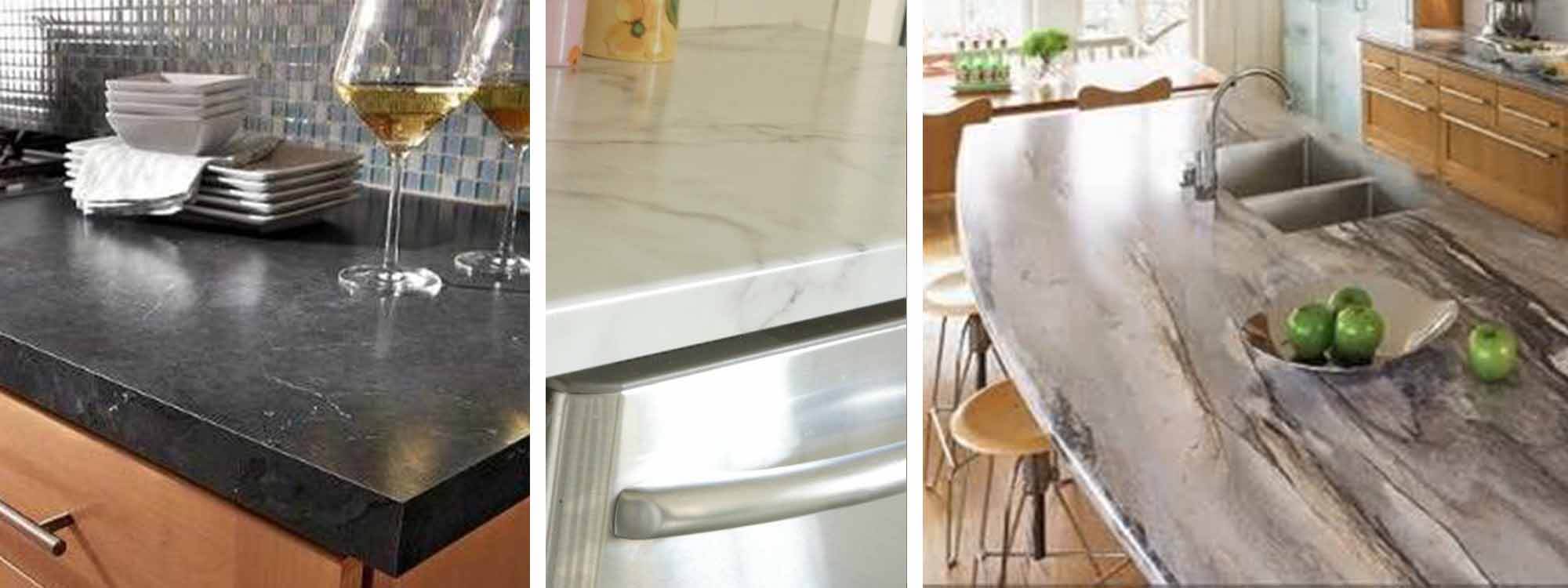
Laminate countertops may conjure up the image of the stained, peeling countertops in the dated kitchens of our youth. But just as kitchen design has evolved, so has laminate. It’s made from layers of paper pressed and laminated to particleboard. It’s one of the most widely used countertop options mostly because of its budget-friendly prices point, but also because of the amazing selection of colours and patterns.
Durability – if looked after, these counters will last a long time, but not as long as their natural competitors.
Maintenance – Stain resistant and can be wiped clean with nonabrasive cleaners.
Style – The colours and textures are vast, and now more realistic metal, marble, granite, and wood patterns are gaining popularity. That little brown line along the edge is a thing of the past, they now can mimic the edging of real stone tops to be rounded or. Higher-end products offer greater variety in luster or sheen and texture.
Cons – They can show scratches, cracks and general wear over time. Abrasives and sharp knives can leave marks that are difficult to repair. They are not heat resistant and can sometimes show marks from a hot pot. They don’t typically add to the resale value of your home.
Price – Lowest cost per square foot and can start below $10/sq.ft.
2. Solid Surface/Acrylic /Corian
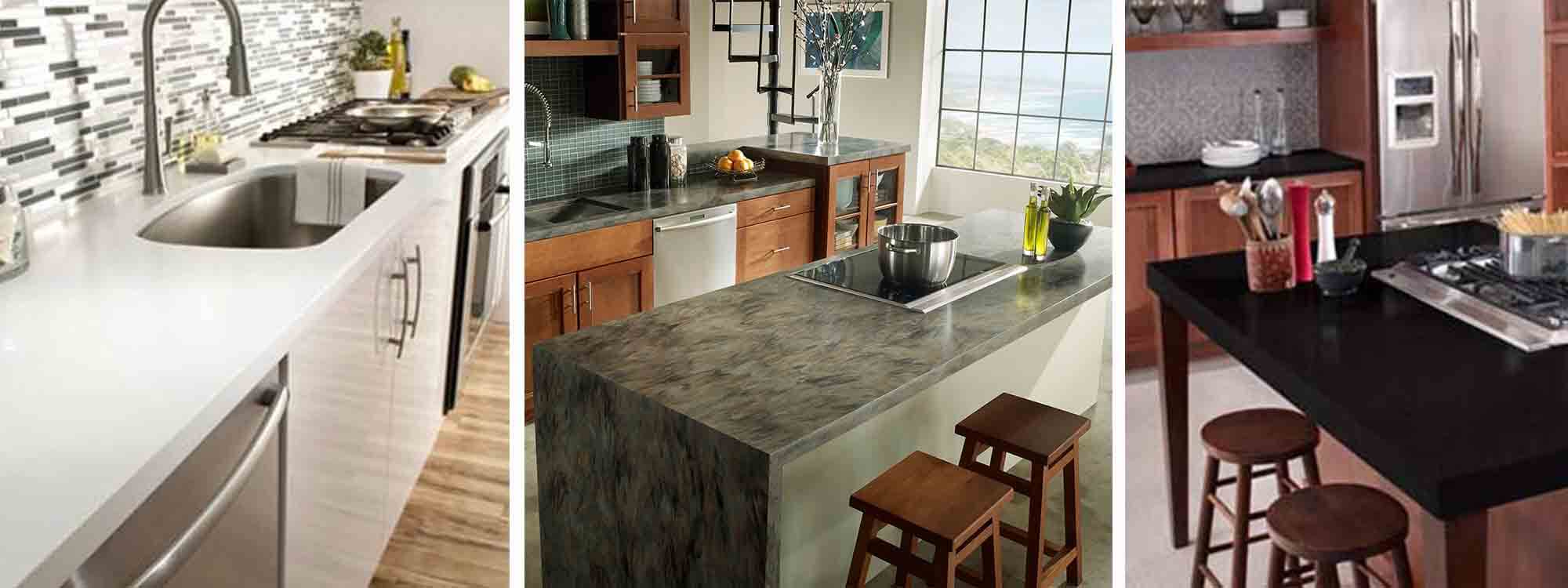
This is very similar to quartz but is made of about 33% acrylic resin and about 66% natural minerals. An especially appealing feature is that it is easy to fabricate and can create completely seamless countertops, unlike other surfaces.
Durability – Like Quartz, they are an extremely hard surface, stain, and scratch resistant but are even more easily repaired and quick to install.
Maintenance – They are also non-porous so don’t require sealing and are antibacterial and hygienic. Easily cleaned with water or a mild detergent.
Style –They have a softer, warmer feel than stone, and are available in a huge range of colors and styles. It can be formed into nearly any shape so integrating features like sinks, drain boards, and backsplashes is possible.
Cons – Not as heat resistant and can be scratched or dented easier then solid stone. Some people are turned-off at the idea that they are man-made and not a natural option.
Price – Mid-range price point.
3. Wood
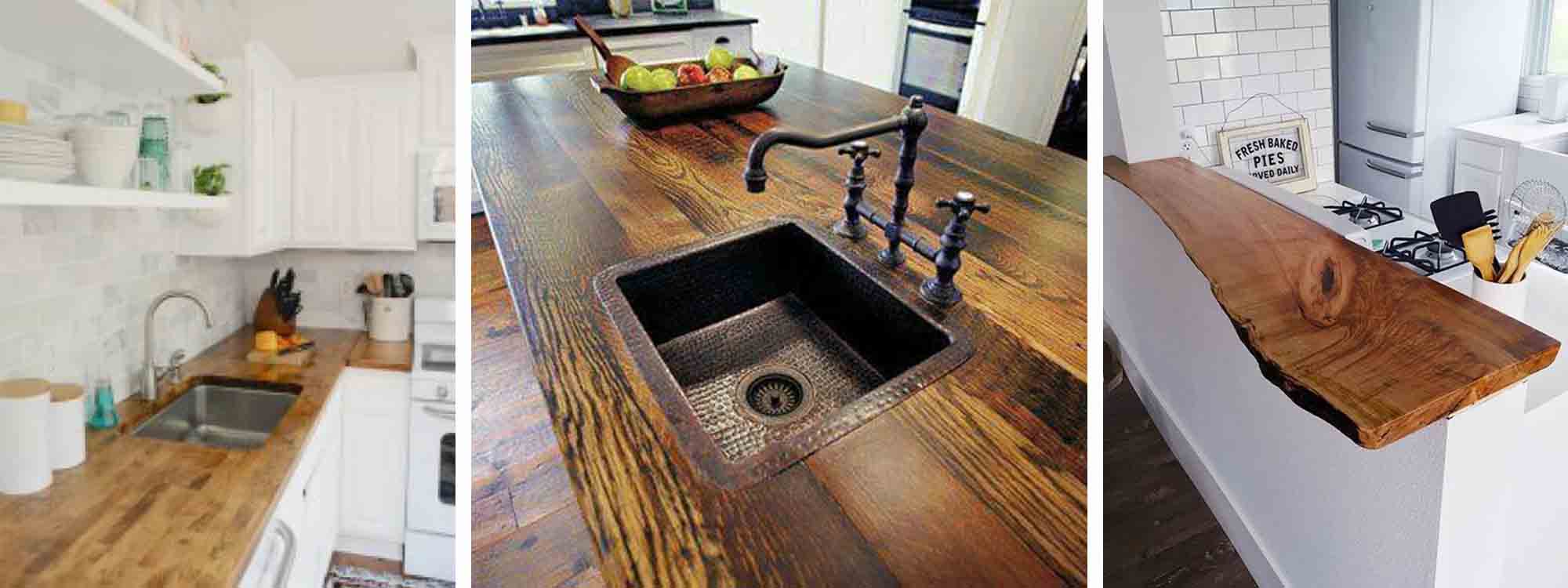
Wood countertops have been used for hundreds of years. Each counter is unique, natural and can add warmth to any space. Various types of wood and finishes can be used to fit different decor and lifestyles.
Durability – If well looked after, these counters will last a long time. Wood is much softer then stone, so is gentler on your glasses, dishes and knives.
Maintenance – The surface will need to be sealed correctly and treated often with mineral oil or other protectant. The seal will need to be reapplied after a few years, or the entire surface sanded and refinished. With time, a wood countertop will begin to show wear and tear.
Style – Wood types mainly include maple, cherry, oak, birch, teak, and bamboo (which is technically a grass). Stains and finishes can customize each top. Common edging options and styles include butcher block, parquet, face grain or end grain planks, panels – they can be modern or rustic depending on your kitchen design and style.
Cons – Water will damage the surface or the seams if left too long. It stains easily unless properly maintained and can easily be dented or damaged (but some homeowners like that aged look).
Price – Mid to higher range price point depending on which wood is used, it’s thickness, etc.
4. Quartz
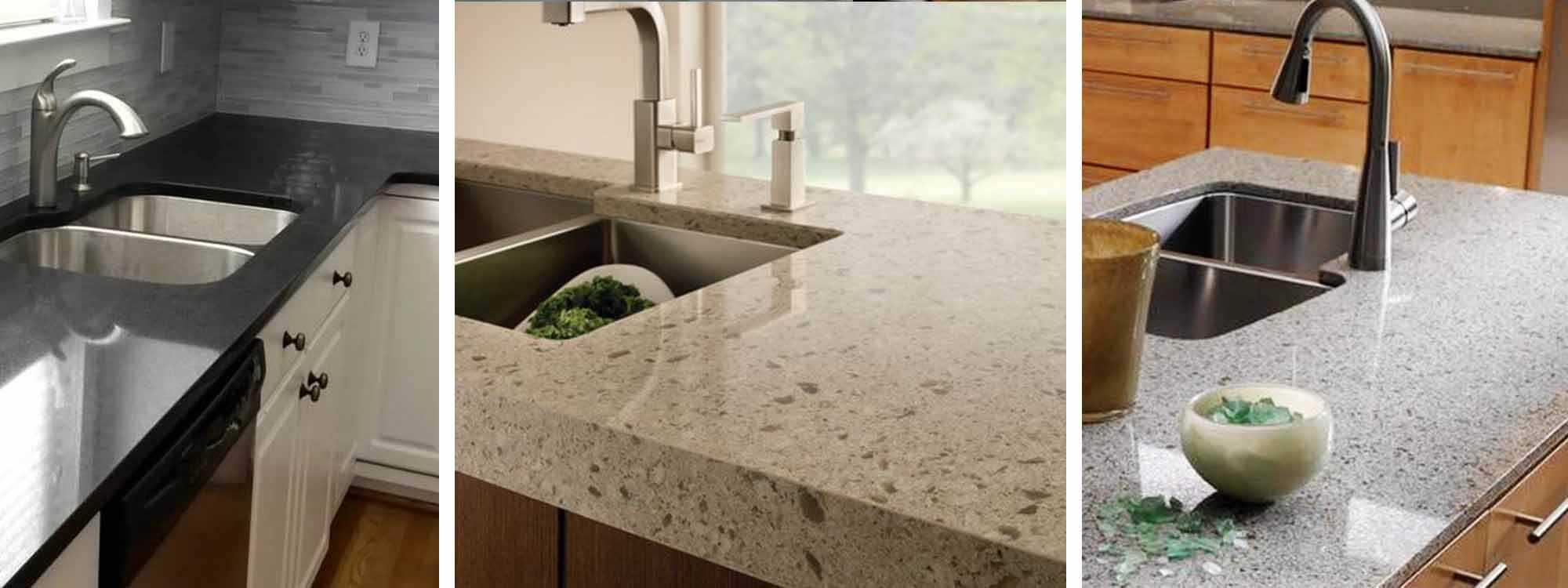
Quartz is an engineered stone, approximately 95 percent natural stone, mixed with 5 percent synthetic resins to bind the stone. They combine the beauty of natural stone with the benefits of solid surface materials.
Durability – Extremely hard surface, stain, and scratch resistant. It’s more flexible then granite which makes it stronger and more tolerant to stress.
Maintenance – They are non-porous so don’t require sealing or wax. It is antibacterial and hygienic.
Style – Available in glossy and matte finishes they have a wide range of colors, and edging options. Unlike natural stone, it doesn’t vary in colour or pattern, so samples will look the same when installed.
Cons – May discolour when exposed to strong sunlight. If chipped, it will require repair by professional. Forgetting a hot pot on this material could react with the resin and leave a mark.
Price – Mid to higher range price point, similar to Wood.
5. Granite
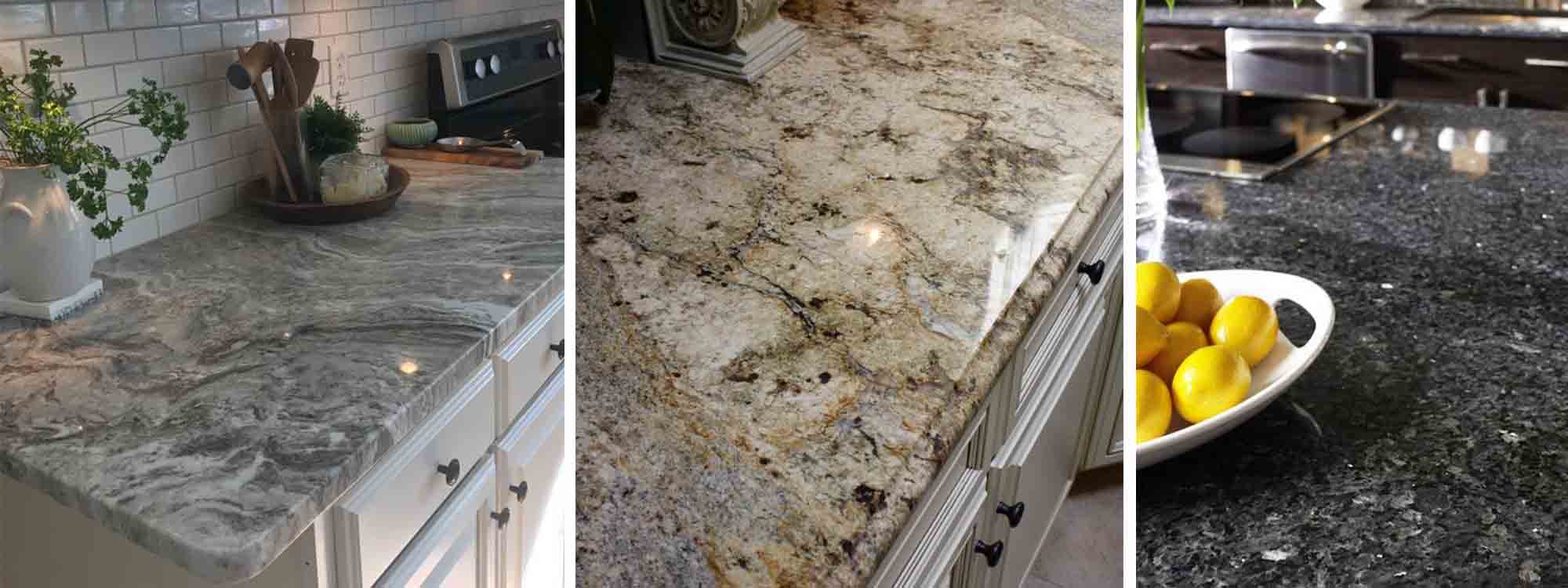
Granite is a natural stone, which is quarried and then cut into large slabs. It’s becoming one of the most common in kitchen renovations and can add value to the resale of your home.
Durability – Heat, stain, and scratch resistant. Water and stain resistant when sealed.
Maintenance – Very porous and can soak up oil and bacteria. If properly sealed (approx. once a year), it can easily be wiped clean. Acidic foods wine, vinegar, bleach, ammonia or harsh chemical cleaners can leave marks.
Style – Each slab is one-of-a-kind with a wide variety of colours, hues, patterns and shading. Colours range from black to white and a variety of earth tones in between. It’s a good idea to choose your slab in person because each slab is unique.
Cons – Slabs can more easily break during transportation then other materials because of it’s rigidity. Some granite contains uranium or other radioactive elements, which can lead to the emission of radon gas, so it’s a good idea to have the supplier test your piece. It’s heavy weight can mean additional supports for your cabinets.
Price – Mid to higher range price point. You can save some money by using a thinner slab or granite tiles
6. Soapstone
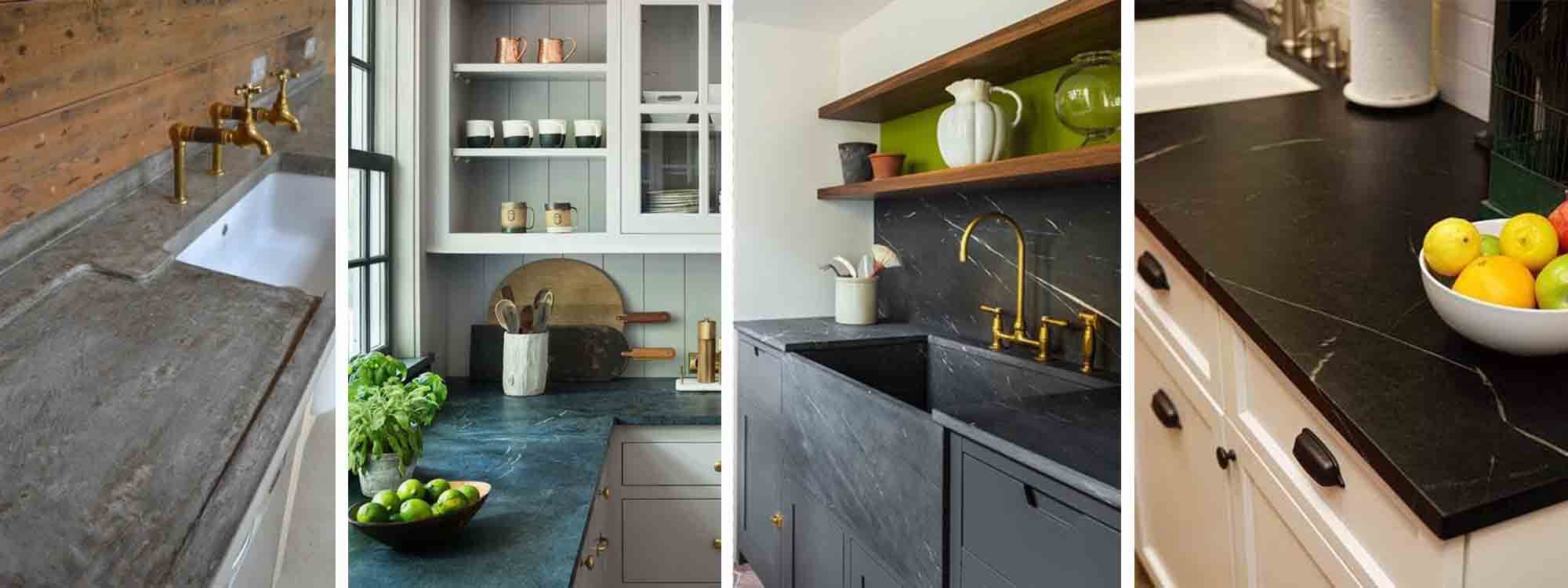
Soapstone is a natural quarried stone and adds a warm rustic touch to your space. Its name comes from the soft, or soapy, feel of its surface caused by talc in the stone.
Durability – Not as hard as granite, but is more pliable and still dense and durable. It’s seen as an environmentally responsible choice.
Maintenance – Nonporous, stain and heat resistant and can stand up to acidic materials. It doesn’t need to be sealed and is virtually maintenance free.
Style – Less common then granite and can make a bold unique statement. It comes in various natural shades of gray, blue and green with some marbling. It can look better as it ages over time and no two slabs are alike..
Cons – Can scratch and chip easily. There’s a limited range of colour so it may not fit with your design. The seams can be quite visible.
Price – On the higher end of price point – comparable to Marble.
7. Marble
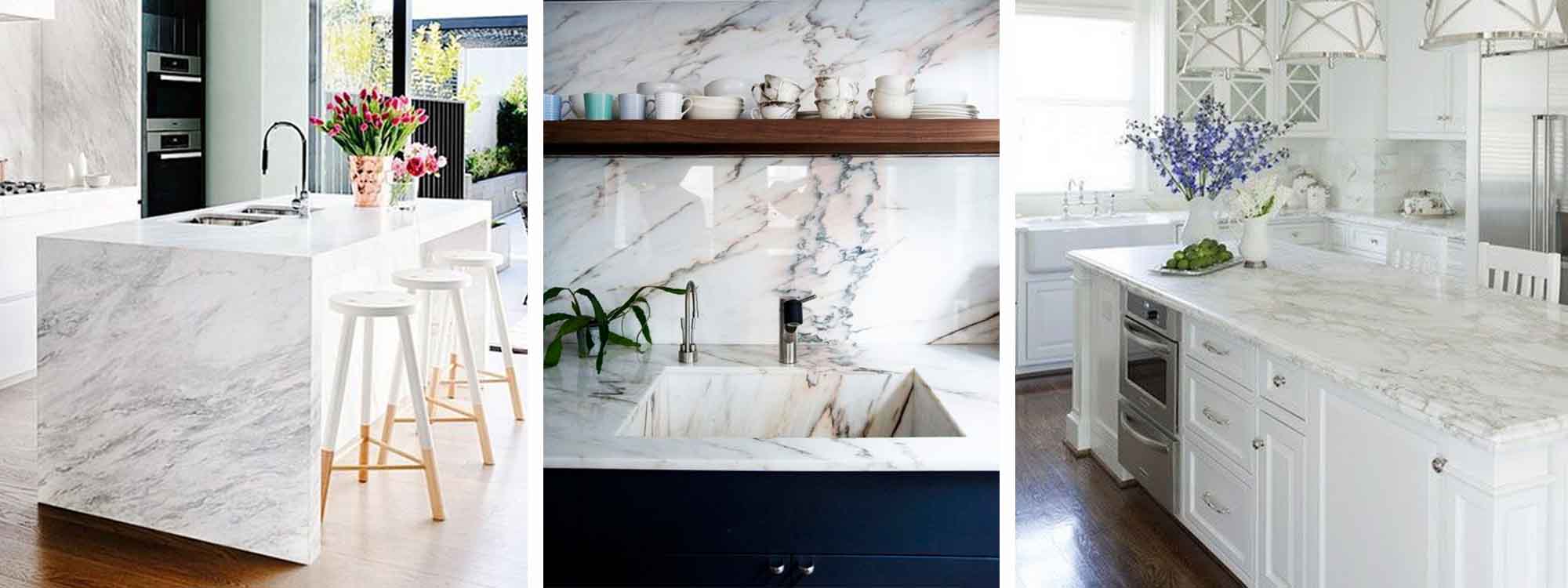
Marble is seen as an elegant and timeless choice. This deep rich natural stone can dress up any kitchen space and pastry chefs love its naturally cool surface.
Durability – Not as hard as granite, but is still dense and durable. It’s heat resistant and won’t yellow with extreme heat.
Maintenance –Small nicks and scratches can be polished out, but it can chip easily and needs to be resealed periodically. On sealed marble most stains wipe away with water.
Style – Soft tones, natural patterns and veins make each slab unique. Colours range from rose, yellow, gray, green, white and black.
Cons – Can be higher maintenance then other materials, scratches and stains easily if seal wears off. It can take on a patina over time, but some people prefer that.
Price – On the higher end of price point. Comparable to Soapstone and dependent on the quality and thickness of the slab.
8. Concrete
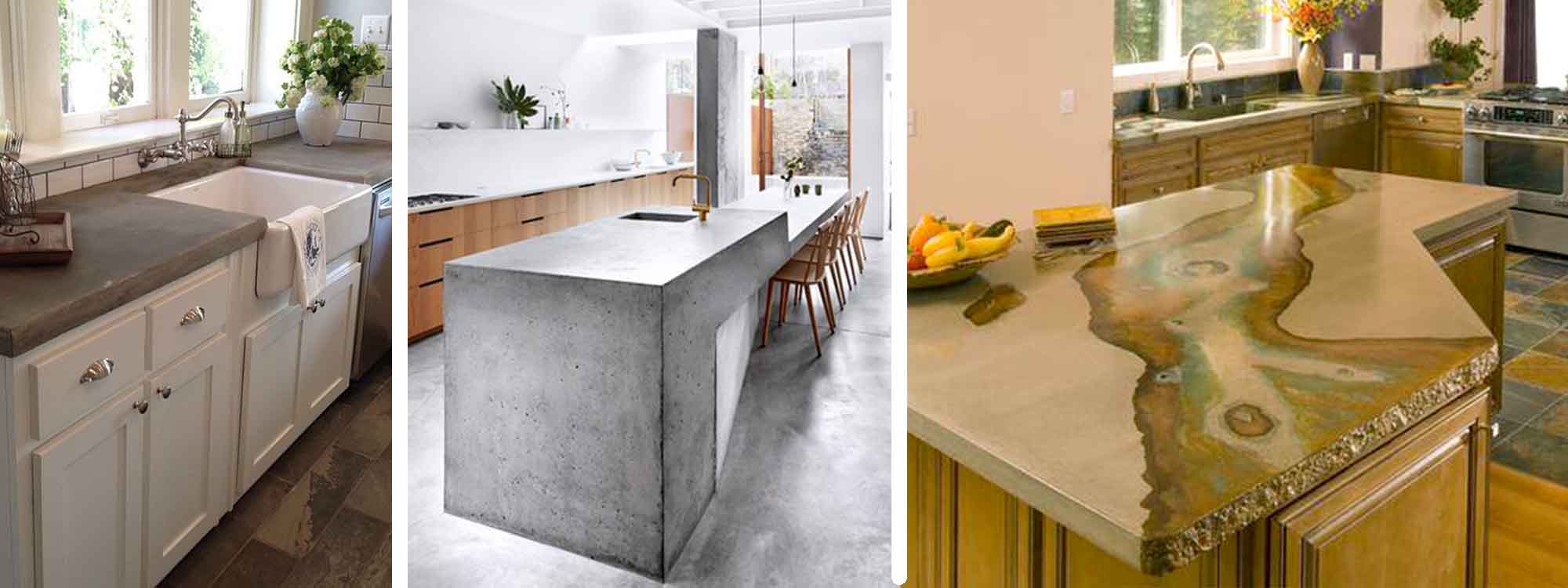
Concrete countertops are made from a general-purpose mortar mix, sand and pigments. They add visual interest and texture to any space. Concrete is not a static material so it will evolve and acquire character over time.
Durability – Extremely durable and practically indestructible
Maintenance – Its porous nature makes it easily stained so topical sealers are needed. It can be more high maintenance then some other options.
Style – They can be customized with any colour or pattern you can imagine. They can integrate shapes like drain boards and can be made to look seamless. Over time, it develops a patina.
Cons – It’s custom formed, so quality may vary. Concrete chips and scratches easier than other materials, and can develop hairline cracks. Like stone and other solid counter tops, concrete can be hard on glasses, dishes and knives.
Price – On the higher end of price point depending on the thickness and the finishing details or inlays. Also because it is more labour intensive to install and needs to be constructed on site.
8. Stainless Steel
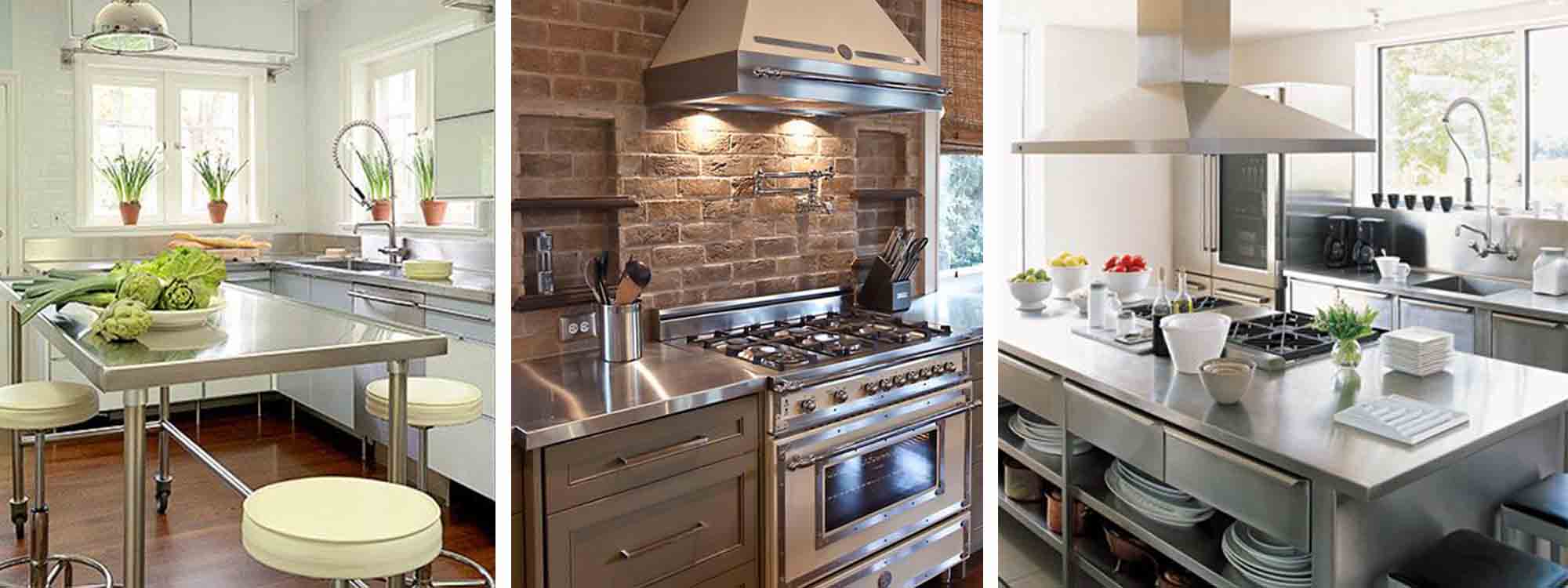
Mainly chosen for its commercial look, stainless steel countertops are great design choice for serious cooks and can add a modern or industrial feel to any space.
Durability – It’s durable, with a long lifespan, is heat resistant and nonporous material prevents bacteria and stains. They won’t rust, chip, fade or corrode.
Maintenance – Low maintenance and easily cleaned.
Style – As it scratches, it starts to patina which often homeowners look for. Brushed stainless steel can help camouflage some of the wear and tear
Cons – It can be easily scratched, dented, and shows age over time. It shows finger prints and smudges easily (but is easy to wipe clean).
Price – Upper end of price point because of it’s labour intensive construction. (The two step process starts with creating a wood form, then molding the steel sheet around the form.) Pre-fabricated options can lower the cost.
Remember: There’s no such thing as the BEST countertop surface, there’s only the BEST FIT for YOU. Your lifestyle, kitchen design style, and overall budget will help guide your decisions.
Hop over to our Kitchen Gallery page to see some of our favourite projects and how their counters play a role in the overall design.

